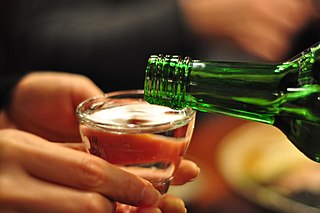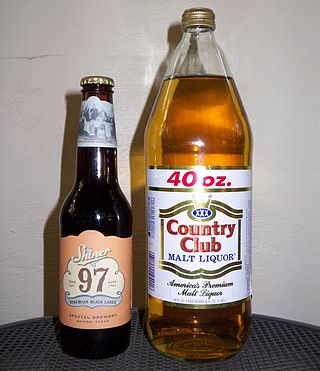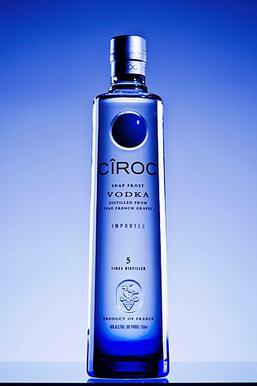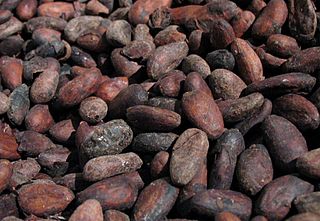Related Research Articles

An alcopop is any of certain mixed alcoholic beverages with relatively low alcohol content, including:
- Malt beverages to which various fruit juices or other flavorings have been added
- Wine coolers: beverages containing wine to which ingredients such as fruit juice or other flavorings have been added
- Mixed drinks containing distilled alcohol and sweet liquids such as fruit juices or other flavourings

Coca-Cola, or Coke, is a carbonated soft drink manufactured by the Coca-Cola Company. In 2013, Coke products were sold in over 200 countries worldwide, with consumers drinking more than 1.8 billion company beverage servings each day. Coca-Cola ranked No. 87 in the 2018 Fortune 500 list of the largest United States corporations by total revenue. Based on Interbrand's "best global brand" study of 2020, Coca-Cola was the world's sixth most valuable brand.

Fortified wine is a wine to which a distilled spirit, usually brandy, has been added. In the course of some centuries, winemakers have developed many different styles of fortified wine, including port, sherry, madeira, Marsala, Commandaria wine, and the aromatised wine vermouth.

Vermouth is an aromatized fortified wine, flavoured with various botanicals and sometimes colored. The modern versions of the beverage were first produced in the mid to late 18th century in Turin, Italy. While vermouth was traditionally used for medicinal purposes, it was later served as an apéritif, with fashionable cafés in Turin serving it to guests around the clock. In the late 19th century, it became popular with bartenders as a key ingredient for cocktails, such as the martini, the Manhattan, the Rob Roy, and the Negroni. In addition to being consumed as an aperitif or cocktail ingredient, vermouth is sometimes used as an alternative to white wine in cooking.

Vodka is a clear distilled alcoholic beverage. Different varieties originated in Poland, Russia, and Sweden. Vodka is composed mainly of water and ethanol but sometimes with traces of impurities and flavourings. Traditionally, it is made by distilling liquid from fermented cereal grains, and potatoes since introduced in Europe in the 1700s. Some modern brands use corn, sugar cane, fruits, honey, and maple sap as the base.

Wine is an alcoholic drink made from fermented fruit. Yeast consumes the sugar in the fruits and converts it to ethanol and carbon dioxide, releasing heat in the process. Though wine can be made from a variety of fruit crops such as plum, cherry, pomegranate, blueberry, currant and elderberry, it is most often made from grapes, and the term "wine" generally refers to grape wine when used without a qualifier.

Soju is a clear and colorless Korean distilled alcoholic beverage. It is usually consumed neat. Its alcohol content varies from about 12.9% to 53% alcohol by volume (ABV), although since 2007 low alcohol soju below 20% has become more popular.

Boxed wine is a wine sold in "bag-in-box" packaging. Traditionally, this consists of a cardboard box containing a wine filled plastic reservoir. The flow of the wine from the box is controlled by a valve.

Buckfast Tonic Wine is a caffeinated alcoholic drink consisting of fortified wine with added caffeine, originally made by monks at Buckfast Abbey in Devon, England. It is now made under a licence granted by the monastery, and distributed by J. Chandler & Company in Great Britain, James E McCabe Ltd in Northern Ireland, and Richmond Marketing Ltd in Ireland. It is based on a traditional recipe from France. The wine's distributor reported record sales of £43.2 million as of March 2017.

Malt liquor is a type of mass market beer with high alcohol content, most closely associated with North America. Legally, it often includes any alcoholic beverage with 5% or more alcohol by volume made with malted barley. In common usage, it refers to beers of high alcohol content, generally above 6%, which are made with ingredients and processes resembling those for American-style lagers.

Shasta Beverages is an American soft drink manufacturer that markets a value-priced soft drink line with a wide variety of soda flavors, as well as a few drink mixers, under the brand name Shasta. The company name is derived from Mount Shasta in northern California and the associated Shasta Springs.

Constellation Brands, Inc. is an American producer and marketer of beer, wine, and spirits. A Fortune 500 company, Constellation is the largest beer import company in the US, measured by sales, and has the third-largest market share of all major beer suppliers. It also has sizable investments in medical and recreational cannabis through its association with Canopy Growth. Based in Victor, New York, Constellation has about 40 facilities and approximately 9,000 employees.

Cîroc is a brand of alcoholic beverages produced in France since 2003 and owned by the British-based multinational alcoholic beverage maker Diageo. The brand family includes vodka, flavored products containing vodka, and brandy. From 2007 the marketing and promotion for Cîroc in the United States was in conjunction with rapper Sean Combs in an "equal-share venture" with profits from the brand being split between Combs and Diageo, but this was terminated in 2024 after a legal dispute, leaving Diageo the sole owner.

Flavored fortified wines or tonic wines are inexpensive fortified wines that typically have an alcohol content between 13% and 20% alcohol by volume (ABV). They are made from various fruits with added sugar, artificial flavor, and artificial color.

Chocolate liqueur is a chocolate flavored liqueur made from a base liquor of whisky or vodka. Unlike chocolate liquor, chocolate liqueur contains alcohol. Chocolate liqueur is often used as an ingredient in mixology, baking, and cooking.
White Mountain Cooler was an alcoholic beverage that debuted in the US market in 1985. It was produced by the Stroh Brewery Company. By 1987, it was ranked fifth in the malted beverage cooler market.

Monster Beverage Corporation is an American beverage company that manufactures energy drinks including Monster Energy, Relentless and Burn. The company was originally founded as Hansen's in 1935 in Southern California, originally selling juice products. The company renamed itself as Monster Beverage in 2012.
Ready to drink packaged beverages are those sold in a prepared form, ready for consumption. Examples include iced tea and alcopops.

An alcoholic beverage is a drink that contains ethanol, a type of alcohol and is produced by fermentation of grains, fruits, or other sources of sugar. The consumption of alcoholic drinks, often referred to as "drinking", plays an important social role in many cultures. Alcoholic drinks are typically divided into three classes—beers, wines, and spirits—and typically their alcohol content is between 3% and 50%.

The Fun Wine Company, Inc. is an American alcoholic beverage company headquartered in Miami, Florida. Founded in 2010, it manufactures gluten-free wine cocktails, whose products are distributed in the United States by Republic National Distributing Company. In 2021, their executives has announced a global expansion to markets in Asia, Latin America and Europe.
References
- ↑ Wine & Spirit International. Evro Publishing Company. July 1994. pp. 50–55.
- ↑ Beauchamp, Tom L. (2004). Case Studies in Business, Society, and Ethics. Pearson Prentice Hall. pp. 169–174. ISBN 978-0-13-099435-6.
- 1 2 3 Cross, Huntley J. (1990-11-25). "FORTIFIED WINE: FIVE FLAVORS OF DANGER 'LIQUID CRACK'". Baltimore Sun. Retrieved 2023-12-26.
- ↑ Martin, Scott C. (2014-12-16). The SAGE Encyclopedia of Alcohol: Social, Cultural, and Historical Perspectives. SAGE Publications. p. 1404. ISBN 978-1-4833-3108-9.
- ↑ Siler, Julia Flynn (2007). The House of Mondavi: The Rise and Fall of an American Wine Dynasty. Penguin. p. 332. ISBN 978-1-59240-259-5.
- ↑ Kryza, Andy (2014-01-10). "Ranking the Top-5 Bum Wines, From Thunderbird to Mad Dog 20/20". Thrillist. Retrieved 2023-12-26.
- 1 2 Ap (1991-01-10). "Surgeon General Calls Potent Wine a Threat". The New York Times. ISSN 0362-4331 . Retrieved 2023-12-26.
- ↑ Beauchamp; Bowie (August 1999). Ethical Theory Bus Uni Phoened (a1). Pearson Prentice Hall. p. 478. ISBN 978-0-13-016715-6.
- ↑ "BAN ON CISCO WINE URGED". Greensboro News and Record. 1991-01-09. Retrieved 2023-12-26.
- 1 2 Walsh-Childers, Kim (2016-12-01). Mass Media and Health: Examining Media Impact on Individuals and the Health Environment. Routledge. ISBN 978-1-317-40690-7.
- 1 2 Cross, Huntley J. (1991-01-06). "CISCO WINE IS FULL OF SURPRISES, ALCOHOL OFFICIALS SAYS". Baltimore Sun. Retrieved 2023-12-26.
- ↑ African-American law & policy report. 1997. p. 298.
- 1 2 "The maker of Cisco, a flavored wine product with... - UPI Archives". UPI. Retrieved 2023-12-26.
- ↑ "CISCO WINE TO GET NEW PACKAGING". Washington Post. ISSN 0190-8286 . Retrieved 2023-12-26.
- ↑ Company, DIANE Publishing (1995). Youth and Alcohol: A National Survey, Drinking Habits, Access, Attitudes, and Knowledge. DIANE Publishing. pp. 1–14. ISBN 978-0-7881-2412-9.
- ↑ Sun, Baltimore (1990-12-30). "LET'S SET THE RECORD STRAIGHT ON CISCO WINE". Baltimore Sun. Retrieved 2023-12-26.
- ↑ Jurkiewicz, Carole L.; Painter, Murphy J. (2007-11-14). Social and Economic Control of Alcohol: The 21st Amendment in the 21st Century. CRC Press. p. 129. ISBN 978-1-4200-5464-4.
- 1 2 3 Gladwell, Malcolm (January 10, 1991). "SURGEON GENERAL DENOUNCES MARKETING OF POTENT WINE". Washington Post.
- ↑ Albright, David (1996). The Divided Highway: Transportation Equity and Violence. Alliance for Transportation Research. p. 37.
- ↑ "WINE DRINK'S PACKAGING A TRICK, GROUPS WARN". Chicago Tribune. 1990-09-14. Retrieved 2023-12-26.
- ↑ RAEKE, CAROLYN RAEKE AND MICHAEL BEEBE, CHARLES ANZALONE AND MICHAEL BEEBE, DAN HERBECK AND MICHAEL BEEBE, GENE WARNER AND MICHAEL BEEBE, JANE KWIATKOWSKI AND MICHAEL BEEBE, JIMMY THOMPSON AND MICHAEL BEEBE, JON R. SORENSEN AND MICHAEL BEEBE, JUAN FORERO AND MICHAEL BEEBE, Michael Beebe, MICHAEL BEEBE AND CAROLYN (1991-01-20). "DISPUTE FERMENTS OVER ABUSE OF CISCO WINE; CRITICS SAY CANANDAIGUA PRODUCT IS DECEPTIVE, DANGEROUS TO YOUNG". Buffalo News. Retrieved 2023-12-26.
{{cite web}}: CS1 maint: multiple names: authors list (link) - ↑ "CANANDAIGUA WINE CO. AGREES TO ADVERTISING, PACKAGING CHANGES FOR CISCO FORTIFIED WINE TO SETTLE FTC CHARGES". ftc.gov. 1991-03-12. Archived from the original on 2007-10-18. Retrieved 2023-12-26.
- ↑ Turner, Douglas (1991-01-29). "HOUSE PANEL CHIEF ASSAILS CANANDAIGUA'S CISCO WINE". Buffalo News. Retrieved 2023-12-26.
- ↑ Inciardi, James A.; McElrath, Karen (2001). The American Drug Scene. Roxbury. p. 108. ISBN 978-1-891487-36-1.
- ↑ Adler, Patricia A.; Adler, Peter; O'Brien, Patrick K. (2012-02-28). Drugs and the American Dream: An Anthology. John Wiley & Sons. p. 81. ISBN 978-0-470-67027-9.
- ↑ Barrack, Samuel (2011). Social Medicine in the 21st Century: Thematic Collection. iMedPub. p. 102. ISBN 978-1-4610-9613-9.
- 1 2 Kenan, Randall (2000-02-22). Walking on Water: Black American Lives at the Turn of the Twenty-First Century. Knopf Doubleday Publishing Group. p. 481. ISBN 978-0-679-73788-9.
- 1 2 Liu, Eric (1994). Next: Young American Writers on the New Generation. W. W. Norton & Company. p. 51. ISBN 978-0-393-31191-4.
- ↑ Reynolds, David S.; Rosenthal, Debra J. (1997). The Serpent in the Cup: Temperance in American Literature. University of Massachusetts Press. p. 213. ISBN 978-1-55849-081-9.
- ↑ Luke - I Got S--t on My Mind Album Reviews, Songs & More | AllMusic , retrieved 2024-01-26
- ↑ Jones, Melvyn "Deacon"; Jones, Melvyn (2008). The Blues Man: 40 Years with the Blues Legends. AuthorHouse. p. 13. ISBN 978-1-4343-7571-1.